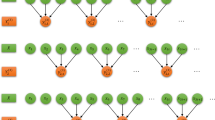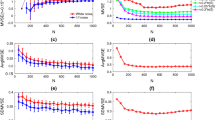Abstract
Refined multiscale entropy (RMSE) technique was introduced to evaluate complexity of a time series over multiple scale factors ‘t’. Here threshold value ‘r’ is updated as 0.15 times SD of filtered scaled time series. The use of fixed threshold value ‘r’ in RMSE sometimes assigns very close resembling entropy values to certain time series at certain temporal scale factors and is unable to distinguish different time series optimally. The present study aims to evaluate RMSE technique by varying threshold value ‘r’ from 0.05 to 0.25 times SD of filtered scaled time series and finding optimal ‘r’ values for each scale factor at which different time series can be distinguished more effectively. The proposed RMSE was used to evaluate over HRV time series of normal sinus rhythm subjects, patients suffering from sudden cardiac death, congestive heart failure, healthy adult male, healthy adult female and mid-aged female groups as well as over synthetic simulated database for different datalengths ‘N’ of 3000, 3500 and 4000. The proposed RMSE results in improved discrimination among different time series. To enhance the computational capability, empirical mathematical equations have been formulated for optimal selection of threshold values ‘r’ as a function of SD of filtered scaled time series and datalength ‘N’ for each scale factor ‘t’.










Similar content being viewed by others
Notes
http://www.physionet.org website.
References
Acharya, U. R., K. P. Joseph, N. Kannathal, C. M. Lim, and J. S. Suri. Heart rate variability: a review. Med. Bio. Eng. Comput. 44(12):1031–1051, 2006.
Angelini, L., R. Maestri, D. Marinazzo, L. Nitti, M. Pellicoro, G. D. Pinna, S. Stramaglia, and S. A. Tupputi. Multiscale analysis of short term heart beat interval, arterial blood pressure and instantaneous lung volume time series. Artif. Intell. Med. 41(3):237–250, 2007.
Aziz, W., F. S. Schlindwein, M. Wailoo, T. Biala, and F. C. Rocha. Heart rate variability of normal and growth restricted children. Clin. Auton. Res. 22:91–97, 2011.
Bari, V., Valencia, J. F., Vallverdu, M., Girardengo, G., Bassani, T., Marchi, A., Calvillo, L., Caminal, P., Cerutti, S., Brink, P.A., Crotti, L., Schwartz P. J., and Porta, A. Refined multiscale entropy analysis of heart period and QT interval variabilities in long QT syndrome type-1 patients. In Proceeding of IEEE Engineering in Medicine and Biology Society, pp. 5554–5557, 2013.
Chandra, T., Yeates, D. B., and Wong, L. B. Heart rate variability analysis—current and future trends. A Report in Business Briefing: Global Healthcare, pp. 1–5, 2003.
Costa, M., A. L. Goldberger, and C.-K. Peng. Multiscale entropy analysis of complex physiologic time series. Phys. Rev. Lett. 89(6):068102-1–068102-4, 2002.
Costa, M., A. L. Goldberger, and C.-K. Peng. Multiscale entropy analysis of biological signals. Phys. Rev. E 71(2):021906-1–021906-17, 2005.
Ferrario, M., M. G. Signorini, G. Magenes, and S. Cerutti. Comparison of entropy-based regularity estimators: application to the fetal heart rate signal for the identification of fetal distress. IEEE Trans. Biomed. Eng. 53(1):119–125, 2006.
Goldberger, J. J. Sympathovagal balance: how should we measure it. Am. J. Physiol. Heart Circ. Physiol. 276(4):H1273–H1280, 1999.
Goldberger, A. L., C. K. Peng, and L. A. Lipsitz. What is physiologic complexity and how does it change with aging and disease? Neurobiol. Aging 23:23, 2002.
Hornero, R., D. Abásolo, J. Escudero, and C. Gomez. Nonlinear analysis of electroencephalogram and magnetoencephalogram recordings in patients with Alzheimer’s disease. Philos. Trans. R. Soc. A 367(1887):317–336, 2009.
Humeau, A., G. Mahe, F. C. Blondeau, D. Rousseau, and P. Abraham. Multiscale analysis of microvascular blood flow: a multiscale entropy study of laser Doppler flowmetry time series. IEEE Trans. Biomed. Eng. 58(10):2970–2972, 2011.
Kemper, K. J., C. Hamilton, and M. Atkinson. Heart rate variability: impact of in outlier identification and management strategies on common measures in three clinical populations. Pediat. Res. 62(3):337–342, 2007.
Liu, L., N. Li, W. Zuo, D. Zhang, and H. Zhang. Multiscale Sample Entropy Analysis of Wrist Pulse Blood Flow Signal for Disease Diagnosis. Berlin: Springer, pp. 475–482, 2013.
Malik, M, and Camm, A. J. eds. Heart Rate Variability. Armonk: Futura, 1995.
Malik, M. Heart rate variability-standards of measurement, physiological interpretation and clinical use. Eur. Heart J. 17(3):354–381, 1996.
Marwaha, P., and Sunkaria, R. K. Multi-scale complexity analysis of cardiac variability time series in adult and mid-aged females. In The Proceedings of 2nd International IEEE Conference on Computing for Sustainable Global Development, pp. 1469–1473, 2015.
Oppenheim, A. V., and R. W. Schafer. Digital Signal Processing. Engle-wood Cliffs: Prentice-Hall, 1975.
Pincus, S. M. Approximate entropy as a measure of system complexity. Proc. Natl. Acad. Sci. USA 88(6):2297–2301, 1991.
Pincus, S. M. Approximate entropy (ApEn) as a complexity measure. Chaos 5(1):110–117, 1995.
Rabiner, L. R., and B. Gold. Theory and Application of Digital Signal Processing. Upper Saddle River: Prentice Hall, 1975.
Ramaekers, D., H. Ector, A. E. Aubert, A. Rubens, and F. V. de Werf. Heart rate variability and heart rate in healthy volunteers; is the female autonomic nervous system cardioprotective ? Eur. Heart J. 19(9):1334–1341, 1998.
Rangayyan, R. M. Biomedical Signal Analysis: A Case Study Approach. New York: Wiley, 2002.
Richman, J. S., and J. R. Mooran. Physiological time series analysis using approximate entropy and sample entropy. Am. J. Physiol. Heart Circ. Physiol. 278(6):H2039–H2049, 2000.
Saaleem, S., M. M. Hussain, S. M. I. Majeed, and M. A. Khan. Gender differences of heart rate variability in healthy volunteers. J. Pak. Med. Assoc. 62(5):422–425, 2012.
Sunkaria, R. K., S. C. Saxena, V. Kumar, and A. M. Singhal. Wavelet based R-peak detection for HRV studies”. J. Med. Eng. Technol. 34(2):108–115, 2010.
Thuraisingham, R. A., and G. A. Gottwald. On multiscale entropy analysis for physiological data. Phys. A 366(1):323–332, 2006.
Valencia, J. F., A. Porta, M. Vallverdu, F. Claria, R. Baranowski, E. O. Baranowska, and P. Caminal. Refined multiscale entropy: application to 24-h holter recordings of heart period variability in healthy and aortic stenosis subjects. IEEE Trans. Biomed. Eng. 56(9):2202–2213, 2009.
Wu, S. D., C. W. Wu, S. G. Lin, K. Y. Lee, and C. K. Peng. Analysis of complex time series using refined composite multiscale entropy. Phys. Lett. 378(20):1369–1374, 2014.
Wu, S. D., C. W. Wu, S. G. Lin, C. C. Wang, and K. Y. Lee. Time series analysis using composite multiscale entropy. Entropy 15:1069–1084, 2013.
Xu, Y., and L. Zhao. Filter-based multiscale entropy analysis of complex physiological time series. Phys. Rev. E 88(2):022716-1–022716-13, 2013.
Yoo, C. S., and S. H. Yi. On the physiological validity and the effects of detrending in the multiscale entropy analysis of heart rate variability. J. Korean Phys. Soc. 48(4):670–676, 2006.
Acknowledgement
The authors are grateful to Department of Electronics & Communication Engineering and administration of Dr. B R Ambedkar National Institute of Technology, Jalandhar (Punjab) for providing every kind of technical and administrative help for the present work. The present work has been carried out in its ‘Medical Imaging and Computational Modeling of Physiological Systems Research Laboratory’ and ‘Biomedical Signal Processing and Telemedicine Laboratory’. The authors acknowledge all technical support provided by above laboratories.
Conflict of interest
There is no conflict of interest in respect of the research work being presented in this manuscript.
Human and Animal Studies
All procedures followed were in accordance with the ethical standards of the responsible committee on human experimentation (institutional and national) and with the Helsinki Declaration of 1975, as revised in 2000 (5). Informed consent was obtained from all patients for being included in the study. No animal studies were carried out by the authors for this article.
Author information
Authors and Affiliations
Corresponding author
Additional information
Associate Editor Ajit P. Yoganathan oversaw the review of this article.
Rights and permissions
About this article
Cite this article
Marwaha, P., Sunkaria, R.K. Optimal Selection of Threshold Value ‘r’ for Refined Multiscale Entropy. Cardiovasc Eng Tech 6, 557–576 (2015). https://doi.org/10.1007/s13239-015-0242-x
Received:
Accepted:
Published:
Issue Date:
DOI: https://doi.org/10.1007/s13239-015-0242-x




